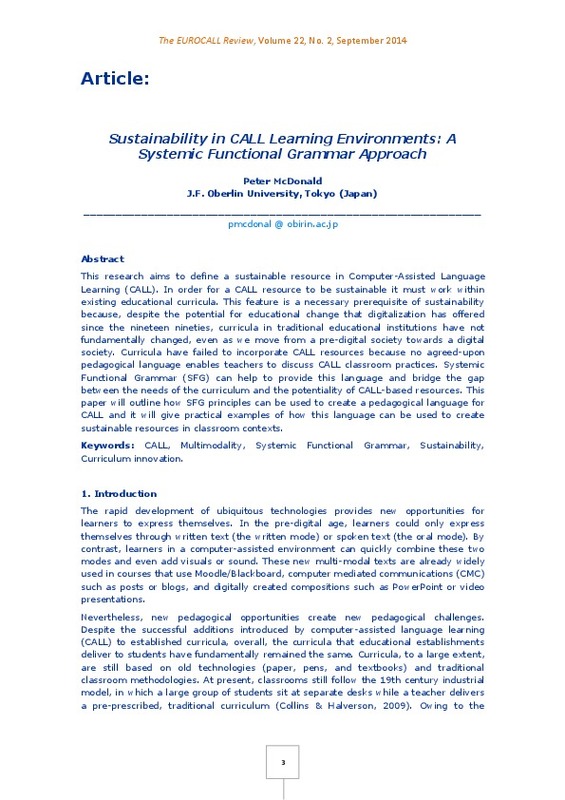JavaScript is disabled for your browser. Some features of this site may not work without it.
Buscar en RiuNet
Listar
Mi cuenta
Estadísticas
Ayuda RiuNet
Admin. UPV
Sustainability in CALL Learning Environments: A Systemic Functional Grammar Approach
Mostrar el registro sencillo del ítem
Ficheros en el ítem
| dc.contributor.author | McDonald, Peter
|
es_ES |
| dc.date.accessioned | 2017-05-25T12:39:49Z | |
| dc.date.available | 2017-05-25T12:39:49Z | |
| dc.date.issued | 2014-09-25 | |
| dc.identifier.uri | http://hdl.handle.net/10251/81770 | |
| dc.description.abstract | [EN] This research aims to define a sustainable resource in Computer-Assisted Language Learning (CALL). In order for a CALL resource to be sustainable it must work within existing educational curricula. This feature is a necessary prerequisite of sustainability because, despite the potential for educational change that digitalization has offered since the nineteen nineties, curricula in traditional educational institutions have not fundamentally changed, even as we move from a pre-digital society towards a digital society. Curricula have failed to incorporate CALL resources because no agreed-upon pedagogical language enables teachers to discuss CALL classroom practices. Systemic Functional Grammar (SFG) can help to provide this language and bridge the gap between the needs of the curriculum and the potentiality of CALL-based resources. This paper will outline how SFG principles can be used to create a pedagogical language for CALL and it will give practical examples of how this language can be used to create sustainable resources in classroom contexts. | es_ES |
| dc.language | Inglés | es_ES |
| dc.publisher | Universitat Politècnica de València | |
| dc.relation.ispartof | The EuroCALL Review | |
| dc.rights | Reconocimiento - No comercial - Sin obra derivada (by-nc-nd) | es_ES |
| dc.subject | CALL | es_ES |
| dc.subject | Multimodality | es_ES |
| dc.subject | Systemic Functional Grammar | es_ES |
| dc.subject | Sustainability | es_ES |
| dc.subject | Curriculum innovation | es_ES |
| dc.title | Sustainability in CALL Learning Environments: A Systemic Functional Grammar Approach | es_ES |
| dc.type | Artículo | es_ES |
| dc.date.updated | 2017-05-25T10:54:59Z | |
| dc.identifier.doi | 10.4995/eurocall.2014.3631 | |
| dc.rights.accessRights | Abierto | es_ES |
| dc.description.bibliographicCitation | Mcdonald, P. (2014). Sustainability in CALL Learning Environments: A Systemic Functional Grammar Approach. The EuroCALL Review. 22(2):3-18. https://doi.org/10.4995/eurocall.2014.3631 | es_ES |
| dc.description.accrualMethod | SWORD | es_ES |
| dc.relation.publisherversion | https://doi.org/10.4995/eurocall.2014.3631 | es_ES |
| dc.description.upvformatpinicio | 3 | es_ES |
| dc.description.upvformatpfin | 18 | es_ES |
| dc.type.version | info:eu-repo/semantics/publishedVersion | es_ES |
| dc.description.volume | 22 | |
| dc.description.issue | 2 | |
| dc.identifier.eissn | 1695-2618 | |
| dc.description.references | Collins, A. & Halverson, R. (2009). Rethinking education in the age of technology. Columbia: Teachers College. | es_ES |
| dc.description.references | Cuban, L. (2001). Oversold and underused: computers in the classroom. Cambridge, MA: Harvard University Press. | es_ES |
| dc.description.references | DeVoss, D.N., Eidman-Aadahl, E., & Hicks, T. (2010). Because Digital Writing Matters. CA: John Wiley & Sons. | es_ES |
| dc.description.references | Fries, P.H. (1994). On Theme Rheme and Discourse Goals. In M. Coulthard (ed.). Advances in Written Text Analysis. (pp. 229- 249). New York: Routledge. | es_ES |
| dc.description.references | Gee, Paul, (2011). Reflections On Empirical Evidence On Games and Learning. In T.Sigmund & J.D. Flechter (Eds.), Computer Games and Instruction. (pp. 223-232). Charlotte NC: Information Age Publishing | es_ES |
| dc.description.references | Hagood, M. (2008). Intersections of Popular Culture, Identities, and New Literacies. In J. Coiro et al (eds). Handbook of Research into New Literacies. (pp. 377-407). New York: Erlbaum. | es_ES |
| dc.description.references | Halliday, M.A.K. & Matthiessen, C.M.I.M. (2004). An Introduction to Functional Grammar. London: Hodder and Arnold. | es_ES |
| dc.description.references | Hoey, M. (2001). Textual Interaction. Oxon: Routledge. | es_ES |
| dc.description.references | Kennedy, C. (2013). Models Of Change and Innovation. In K. Hyland & C. Wong (Eds.), Innovation and Change In English Language Education. (pp. 13-27). Oxen:Routledge. | es_ES |
| dc.description.references | Kress, G. (2003). LITERACY IN THE NEW MEDIA AGE. doi:10.4324/9780203164754 | es_ES |
| dc.description.references | Kress, G. & Van Leeuwen, T. (2006). Reading Images. London: Routledge. | es_ES |
| dc.description.references | Liu, J. (2004). Effects of Comic Strips on L2 Learners’ Reading Comprehension. TESOL Quarterly, 38(2), 225. doi:10.2307/3588379 | es_ES |
| dc.description.references | Luke, C. (2001). Connectivity, Multimodality and Interdisciplinarity. In Reading Research Quarterly, Vol.38, No.3, 397-403. | es_ES |
| dc.description.references | Tim Marchand. (2013). Speech in written form? A corpus analysis of computer-mediated communication. Linguistic Research, 30(2), 217-242. doi:10.17250/khisli.30.2.201308.004 | es_ES |
| dc.description.references | McCloud. S. (1994). Understanding Comics: The Invisible Art. New York: Harper Collins. | es_ES |
| dc.description.references | Mc Donald, J. Haward, J. Dobbin, N. Erskine, G. (2008). Macbeth: The Graphic Novel. Bristol: Classical Comics Ltd. | es_ES |
| dc.description.references | Miller, C.H. (2004). Digital Storytelling. Oxford: Elsevier. | es_ES |
| dc.description.references | Unsworth, L. (2008). Multiliteracies and Metalanguage: Describing Image Text Relations as a Resource for Negotiating Multimodal Texts. In J. Coiro et al. (eds). Handbook of Research into New Literacies. (pp. 377-407). New York: Erlbaum. | es_ES |
| dc.description.references | Royce, T. (2002). Multimodality in the TESOL Classroom: Exploring Visual-Verbal Synergy. TESOL Quarterly, 36(2), 191. doi:10.2307/3588330 | es_ES |
| dc.description.references | Rutherford, W. E. (1987). Second Language Grammar and Teaching. New York: Pearson Education. | es_ES |
| dc.description.references | Stempleski, S. (2013). World Link: Developing English Fluency. Singapore: Cengage | es_ES |
| dc.description.references | Stenglin, M. and Iedema, R. (2001). How to Analyse Visual Images: A Guide for TESOL Teachers. In A. Burns. & C. Coffin. Analyzing English in a Global Context. (pp.194-208) London: Routledge. | es_ES |
| dc.description.references | Selfe, C.L. (2007). Multi-Modal Composition. NJ: Hampton Press. | es_ES |








